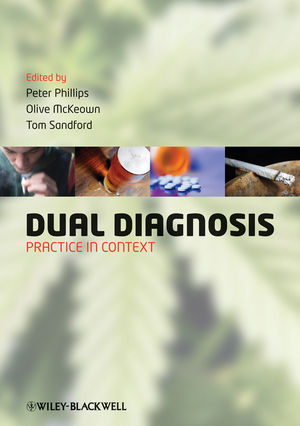Dual Diagnosis: Practice in ContextISBN: 978-1-4051-8009-2
Paperback
288 pages
November 2009, Wiley-Blackwell
 This is a Print-on-Demand title. It will be printed specifically to fill your order. Please allow an additional 10-15 days delivery time. The book is not returnable.
|
||||||
Foreword.
Part 1 Contemporary Context.
1 Definition, Recognition and Assessment (Olive McKeown).
Introduction.
Definition and terminology.
General considerations in the recognition and assessment of dual diagnosis.
How significant is the problem of dual diagnosis?
Recognition and assessment.
Hypotheses.
Conclusion.
2 Explanatory Models for Dual Diagnosis (Peter Phillips and Sonia Johnson).
Introduction.
Is substance misuse more prevalent among people with psychotic illnesses than in the general population?
Which problem generally develops first in dual diagnosis?
Does dual diagnosis have a neurobiological basis?
Is dual diagnosis mediated by personality disorder?
Do people with schizophrenia use substances as a form of self-medication?
Have changes in the care and social circumstances of people with schizophrenia, particularly deinstitutionalisation, led to a rise in substance misuse in this population?
Do the social situations and social difficulties of people with schizophrenia lead to substance use?
Do people with schizophrenia tend to begin using drugs and alcohol within mental health service settings or in the company of other users of such services?
Conclusion.
3 Consumer Perspectives (David Webb).
Introduction.
Human experience and medicine.
Diagnosis, treatment and human rights.
Two worlds.
Significant contrasts.
Diagnosis.
Treatment.
Dual diagnosis and policy.
Conclusion.
Part 2 Common Presentations and Special Populations.
4 Risk Assessment and Dual Diagnosis (Lisa Reynolds and Jenny Oates).
Introduction.
Clinical risk assessment.
Principles of risk assessment and management.
The process of risk assessment and management.
Conclusion.
5 Reducing Drug-Related Harm Among Mentally Ill People (Peter Phillips).
Introduction.
Interventions and approaches.
Harm reduction.
Using harm reduction approaches with mentally ill individuals.
Dual diagnosis and harm reduction: the future?
Conclusion.
6 Motivational Interviewing (Chris Glover).
Introduction.
What is MI?
Conclusion.
7 Psychological Interventions (Patrick Callaghan and David Jones).
Introduction.
The nature and type of psychological interventions.
The evidence for psychological interventions in dual diagnosis.
Individual therapies.
Group therapies.
Cognitive behaviour therapy and relapse prevention.
Family interventions.
Contingency management.
Conclusion.
8 Alcohol and Mood Disorders (Julie Attenborough).
Introduction.
Harm, alcohol and mental illness.
Presentation: alcohol and mental illness.
Medication and dual diagnosis.
Conclusion.
9 Polysubstance Use and Personality Disorder (Simon McArdle).
Introduction.
Prevalence.
Service delivery.
What is personality disorder?
Treatment and intervention approaches.
Assessment.
Stages of change.
Therapeutic principles.
Conclusion.
10 Older People and Dual Diagnosis (Sue Excell).
Introduction.
An increasing population.
Policy framework.
Media representation of information on alcohol.
Perception of old age.
Alcohol use in older people.
Complications of excessive alcohol use.
Assessment and screening.
Under-reporting.
Over-the-counter medication (OTC).
Prescribed medication.
Conclusion.
11 Stimulant Use and Psychosis (Lorna Saunder).
Introduction.
Stimulant use in the United Kingdom.
Stimulants and drug-induced psychosis.
Stimulants and mental illness.
Stimulants and their use by people with existing psychotic illnesses.
Implications for practice.
Conclusion.
12 Women and Dual Diagnosis (Julie Winnington).
Introduction.
Gender differences in dual diagnosis.
The impact of dual diagnosis on families.
Dual diagnosis and domestic violence.
Dual diagnosis within the female prison service.
A case for gender-specific services.
Conclusion.
13 Drug-Induced Psychosis (Hülya Bilgin, Murat Soncul and Peter Phillips).
Introduction.
Dual diagnosis: a common problem.
The relationship between substance use and psychosis: aetiology.
A model of relationships between psychotic illness and drug and alcohol use.
Conclusion.
14 Cannabis Use and Psychosis (Liz Hughes).
Introduction.
What is cannabis?
How is it used?
Legal issues.
How it affects the user.
Psychological effects.
Physical effects.
Safety issues.
The links between cannabis and psychosis.
Interventions for cannabis and psychosis.
Conclusion.
15 Methamphetamine and Mental Health (Melinda Campopiano).
Introduction.
Initiation and continuation of methamphetamine use: missed opportunities.
Methamphetamine and mental health: intoxication, withdrawal and psychiatric illness.
Methamphetamine addiction: treatment and outcomes.
Conclusion.
Acknowledgements.
16 Public Health and Dual Diagnosis (Linda Bailey).
Introduction.
Epidemiology.
Causal relationship.
Treatment for BBV.
Other co-infections.
Conclusion.
17 Comorbidity or Complexity: A Primary Care Perspective on Dual Diagnosis (John Budd).
Introduction.
Policy framework.
Epidemiology.
Key features of general practice care.
Physical health care.
Mental health and substance misuse care.
Limitations and potential in primary care.
Conclusion.
Part 3 International Perspectives, Policy and Development.
18 Dual Diagnosis – North America (Theodora Sirota and Kathleen Leo).
Introduction.
Prevalence.
Historical context.
Socio-cultural and public policy considerations.
Approaches to treatment.
Research.
Issues and challenges.
Conclusion.
19 Dual Diagnosis – Australasia (Gary Croton).
Introduction.
Drivers for system change.
Consumer and carer demand.
Prevalence.
Harms and unwanted outcomes strongly associated with dual diagnosis.
Opportunity to provide more effective treatment of ‘target’ disorders via improved recognition and more effective responses to co-occurring disorders.
Barriers to better outcomes for persons with dual diagnosis.
Indigenous Australians.
Rural and remote regions of Australia.
Australia’s responses to dual diagnosis.
Structure of the Australian health care system.
National level responses to dual diagnosis.
The National Comorbidity Initiative.
Improved Services for People with Drug and Alcohol Problems and Mental Illness Measure.
‘Can Do’ – Managing Mental Health and Substance Use in General.
Practice.
Headspace.
State level responses to dual diagnosis.
Conclusion.
20 Dual Diagnosis – Europe (Jane Salvage and Rob Keukens).
Introduction.
The historical and social context.
Elements of dual diagnosis in the region.
Alcohol.
Other psychoactive substances.
Care and treatment responses.
Problems and solutions.
Conclusion.
21 Commissioning Services for Users with Dual Diagnosis (Sharon Dennis).
Introduction.
Background.
The history of commissioning.
Implications for commissioning dual diagnosis services.
Conclusion.
22 Practice, Research and Education Development (Kevin Gournay).
Introduction.
Research.
Education development.
Practice.
Conclusion.
Index.



